Input interpretation

NaOH sodium hydroxide + F_2 fluorine ⟶ H_2O water + NaF sodium fluoride + F_2O oxygen difluoride
Balanced equation
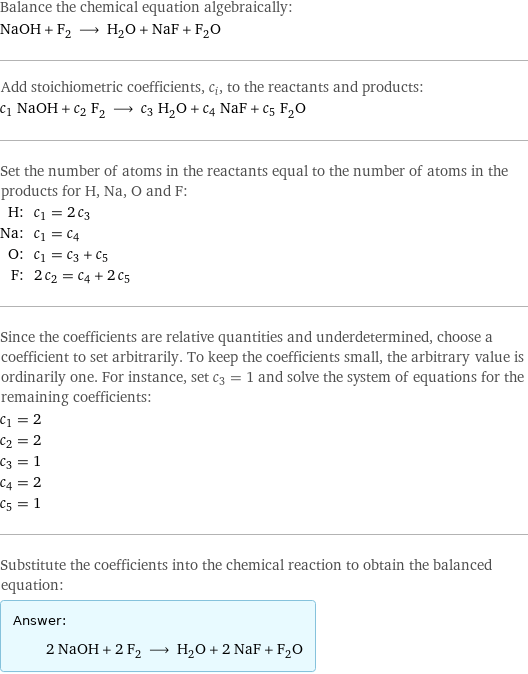
Balance the chemical equation algebraically: NaOH + F_2 ⟶ H_2O + NaF + F_2O Add stoichiometric coefficients, c_i, to the reactants and products: c_1 NaOH + c_2 F_2 ⟶ c_3 H_2O + c_4 NaF + c_5 F_2O Set the number of atoms in the reactants equal to the number of atoms in the products for H, Na, O and F: H: | c_1 = 2 c_3 Na: | c_1 = c_4 O: | c_1 = c_3 + c_5 F: | 2 c_2 = c_4 + 2 c_5 Since the coefficients are relative quantities and underdetermined, choose a coefficient to set arbitrarily. To keep the coefficients small, the arbitrary value is ordinarily one. For instance, set c_3 = 1 and solve the system of equations for the remaining coefficients: c_1 = 2 c_2 = 2 c_3 = 1 c_4 = 2 c_5 = 1 Substitute the coefficients into the chemical reaction to obtain the balanced equation: Answer: | | 2 NaOH + 2 F_2 ⟶ H_2O + 2 NaF + F_2O
Structures

+ ⟶ + +
Names

sodium hydroxide + fluorine ⟶ water + sodium fluoride + oxygen difluoride
Reaction thermodynamics
Enthalpy
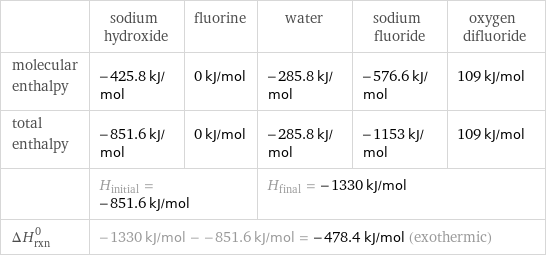
| sodium hydroxide | fluorine | water | sodium fluoride | oxygen difluoride molecular enthalpy | -425.8 kJ/mol | 0 kJ/mol | -285.8 kJ/mol | -576.6 kJ/mol | 109 kJ/mol total enthalpy | -851.6 kJ/mol | 0 kJ/mol | -285.8 kJ/mol | -1153 kJ/mol | 109 kJ/mol | H_initial = -851.6 kJ/mol | | H_final = -1330 kJ/mol | | ΔH_rxn^0 | -1330 kJ/mol - -851.6 kJ/mol = -478.4 kJ/mol (exothermic) | | | |
Gibbs free energy
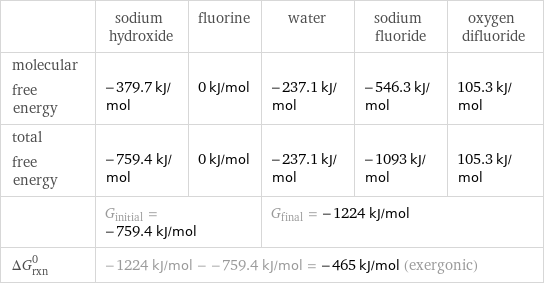
| sodium hydroxide | fluorine | water | sodium fluoride | oxygen difluoride molecular free energy | -379.7 kJ/mol | 0 kJ/mol | -237.1 kJ/mol | -546.3 kJ/mol | 105.3 kJ/mol total free energy | -759.4 kJ/mol | 0 kJ/mol | -237.1 kJ/mol | -1093 kJ/mol | 105.3 kJ/mol | G_initial = -759.4 kJ/mol | | G_final = -1224 kJ/mol | | ΔG_rxn^0 | -1224 kJ/mol - -759.4 kJ/mol = -465 kJ/mol (exergonic) | | | |
Entropy

| sodium hydroxide | fluorine | water | sodium fluoride | oxygen difluoride molecular entropy | 64 J/(mol K) | 202.8 J/(mol K) | 69.91 J/(mol K) | 51.1 J/(mol K) | 216.4 J/(mol K) total entropy | 128 J/(mol K) | 405.6 J/(mol K) | 69.91 J/(mol K) | 102.2 J/(mol K) | 216.4 J/(mol K) | S_initial = 533.6 J/(mol K) | | S_final = 388.5 J/(mol K) | | ΔS_rxn^0 | 388.5 J/(mol K) - 533.6 J/(mol K) = -145.1 J/(mol K) (exoentropic) | | | |
Equilibrium constant
![Construct the equilibrium constant, K, expression for: NaOH + F_2 ⟶ H_2O + NaF + F_2O Plan: • Balance the chemical equation. • Determine the stoichiometric numbers. • Assemble the activity expression for each chemical species. • Use the activity expressions to build the equilibrium constant expression. Write the balanced chemical equation: 2 NaOH + 2 F_2 ⟶ H_2O + 2 NaF + F_2O Assign stoichiometric numbers, ν_i, using the stoichiometric coefficients, c_i, from the balanced chemical equation in the following manner: ν_i = -c_i for reactants and ν_i = c_i for products: chemical species | c_i | ν_i NaOH | 2 | -2 F_2 | 2 | -2 H_2O | 1 | 1 NaF | 2 | 2 F_2O | 1 | 1 Assemble the activity expressions accounting for the state of matter and ν_i: chemical species | c_i | ν_i | activity expression NaOH | 2 | -2 | ([NaOH])^(-2) F_2 | 2 | -2 | ([F2])^(-2) H_2O | 1 | 1 | [H2O] NaF | 2 | 2 | ([NaF])^2 F_2O | 1 | 1 | [F2O] The equilibrium constant symbol in the concentration basis is: K_c Mulitply the activity expressions to arrive at the K_c expression: Answer: | | K_c = ([NaOH])^(-2) ([F2])^(-2) [H2O] ([NaF])^2 [F2O] = ([H2O] ([NaF])^2 [F2O])/(([NaOH])^2 ([F2])^2)](../image_source/a56d13b3aa94ee2fa4d401357ce1379a.png)
Construct the equilibrium constant, K, expression for: NaOH + F_2 ⟶ H_2O + NaF + F_2O Plan: • Balance the chemical equation. • Determine the stoichiometric numbers. • Assemble the activity expression for each chemical species. • Use the activity expressions to build the equilibrium constant expression. Write the balanced chemical equation: 2 NaOH + 2 F_2 ⟶ H_2O + 2 NaF + F_2O Assign stoichiometric numbers, ν_i, using the stoichiometric coefficients, c_i, from the balanced chemical equation in the following manner: ν_i = -c_i for reactants and ν_i = c_i for products: chemical species | c_i | ν_i NaOH | 2 | -2 F_2 | 2 | -2 H_2O | 1 | 1 NaF | 2 | 2 F_2O | 1 | 1 Assemble the activity expressions accounting for the state of matter and ν_i: chemical species | c_i | ν_i | activity expression NaOH | 2 | -2 | ([NaOH])^(-2) F_2 | 2 | -2 | ([F2])^(-2) H_2O | 1 | 1 | [H2O] NaF | 2 | 2 | ([NaF])^2 F_2O | 1 | 1 | [F2O] The equilibrium constant symbol in the concentration basis is: K_c Mulitply the activity expressions to arrive at the K_c expression: Answer: | | K_c = ([NaOH])^(-2) ([F2])^(-2) [H2O] ([NaF])^2 [F2O] = ([H2O] ([NaF])^2 [F2O])/(([NaOH])^2 ([F2])^2)
Rate of reaction
![Construct the rate of reaction expression for: NaOH + F_2 ⟶ H_2O + NaF + F_2O Plan: • Balance the chemical equation. • Determine the stoichiometric numbers. • Assemble the rate term for each chemical species. • Write the rate of reaction expression. Write the balanced chemical equation: 2 NaOH + 2 F_2 ⟶ H_2O + 2 NaF + F_2O Assign stoichiometric numbers, ν_i, using the stoichiometric coefficients, c_i, from the balanced chemical equation in the following manner: ν_i = -c_i for reactants and ν_i = c_i for products: chemical species | c_i | ν_i NaOH | 2 | -2 F_2 | 2 | -2 H_2O | 1 | 1 NaF | 2 | 2 F_2O | 1 | 1 The rate term for each chemical species, B_i, is 1/ν_i(Δ[B_i])/(Δt) where [B_i] is the amount concentration and t is time: chemical species | c_i | ν_i | rate term NaOH | 2 | -2 | -1/2 (Δ[NaOH])/(Δt) F_2 | 2 | -2 | -1/2 (Δ[F2])/(Δt) H_2O | 1 | 1 | (Δ[H2O])/(Δt) NaF | 2 | 2 | 1/2 (Δ[NaF])/(Δt) F_2O | 1 | 1 | (Δ[F2O])/(Δt) (for infinitesimal rate of change, replace Δ with d) Set the rate terms equal to each other to arrive at the rate expression: Answer: | | rate = -1/2 (Δ[NaOH])/(Δt) = -1/2 (Δ[F2])/(Δt) = (Δ[H2O])/(Δt) = 1/2 (Δ[NaF])/(Δt) = (Δ[F2O])/(Δt) (assuming constant volume and no accumulation of intermediates or side products)](../image_source/0a46d2bf65621d2a700f971c76d2645e.png)
Construct the rate of reaction expression for: NaOH + F_2 ⟶ H_2O + NaF + F_2O Plan: • Balance the chemical equation. • Determine the stoichiometric numbers. • Assemble the rate term for each chemical species. • Write the rate of reaction expression. Write the balanced chemical equation: 2 NaOH + 2 F_2 ⟶ H_2O + 2 NaF + F_2O Assign stoichiometric numbers, ν_i, using the stoichiometric coefficients, c_i, from the balanced chemical equation in the following manner: ν_i = -c_i for reactants and ν_i = c_i for products: chemical species | c_i | ν_i NaOH | 2 | -2 F_2 | 2 | -2 H_2O | 1 | 1 NaF | 2 | 2 F_2O | 1 | 1 The rate term for each chemical species, B_i, is 1/ν_i(Δ[B_i])/(Δt) where [B_i] is the amount concentration and t is time: chemical species | c_i | ν_i | rate term NaOH | 2 | -2 | -1/2 (Δ[NaOH])/(Δt) F_2 | 2 | -2 | -1/2 (Δ[F2])/(Δt) H_2O | 1 | 1 | (Δ[H2O])/(Δt) NaF | 2 | 2 | 1/2 (Δ[NaF])/(Δt) F_2O | 1 | 1 | (Δ[F2O])/(Δt) (for infinitesimal rate of change, replace Δ with d) Set the rate terms equal to each other to arrive at the rate expression: Answer: | | rate = -1/2 (Δ[NaOH])/(Δt) = -1/2 (Δ[F2])/(Δt) = (Δ[H2O])/(Δt) = 1/2 (Δ[NaF])/(Δt) = (Δ[F2O])/(Δt) (assuming constant volume and no accumulation of intermediates or side products)
Chemical names and formulas
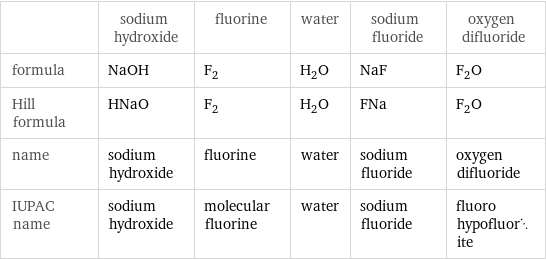
| sodium hydroxide | fluorine | water | sodium fluoride | oxygen difluoride formula | NaOH | F_2 | H_2O | NaF | F_2O Hill formula | HNaO | F_2 | H_2O | FNa | F_2O name | sodium hydroxide | fluorine | water | sodium fluoride | oxygen difluoride IUPAC name | sodium hydroxide | molecular fluorine | water | sodium fluoride | fluoro hypofluorite
Substance properties
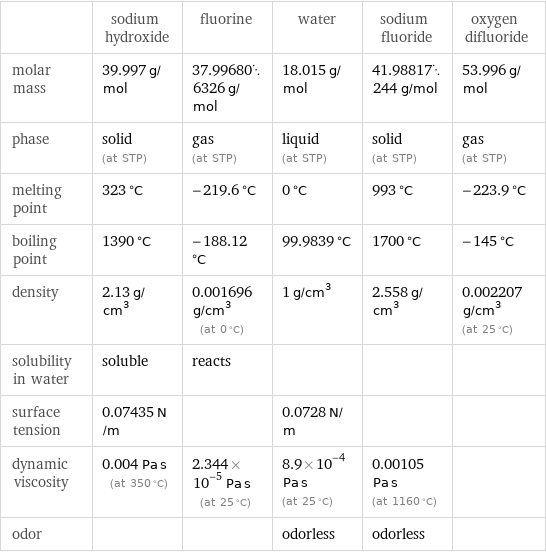
| sodium hydroxide | fluorine | water | sodium fluoride | oxygen difluoride molar mass | 39.997 g/mol | 37.996806326 g/mol | 18.015 g/mol | 41.98817244 g/mol | 53.996 g/mol phase | solid (at STP) | gas (at STP) | liquid (at STP) | solid (at STP) | gas (at STP) melting point | 323 °C | -219.6 °C | 0 °C | 993 °C | -223.9 °C boiling point | 1390 °C | -188.12 °C | 99.9839 °C | 1700 °C | -145 °C density | 2.13 g/cm^3 | 0.001696 g/cm^3 (at 0 °C) | 1 g/cm^3 | 2.558 g/cm^3 | 0.002207 g/cm^3 (at 25 °C) solubility in water | soluble | reacts | | | surface tension | 0.07435 N/m | | 0.0728 N/m | | dynamic viscosity | 0.004 Pa s (at 350 °C) | 2.344×10^-5 Pa s (at 25 °C) | 8.9×10^-4 Pa s (at 25 °C) | 0.00105 Pa s (at 1160 °C) | odor | | | odorless | odorless |
Units
